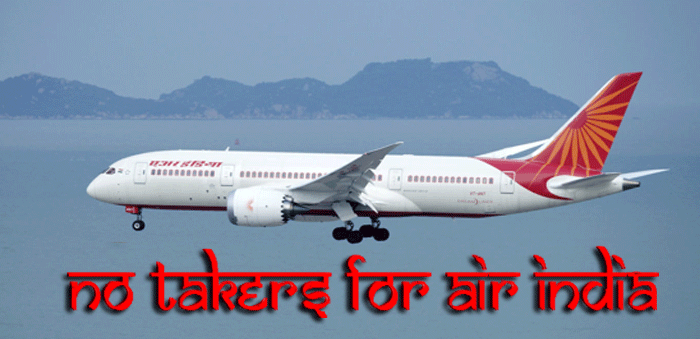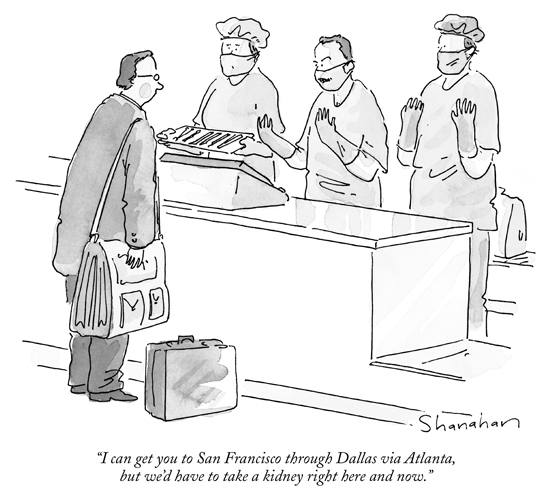
There has been no let-up in the downs
for Air India.
Caught in a tight-jacketed financial
bind and living from day to day on taxpayers’ money, the Narendra
Modi-led government took the move to sell Air India.
Despite the best efforts of the Civil
Aviation Ministry, not one bidder showed interest in Air India till May
31, the deadline for the ‘Expression of Interest’ (EOI) bids
under AI’s divestment process.
Lukewarm
Response To Buyout
In fact, the government, witnessing
only a lukewarm interest in the divestment process, had sweetened the
deal in its EOI on May 1 including plans for retaining the 24 percent
stake in the divested entity, provision of ESOPs (employee stock ownership
plan) and on the total debt and liabilities that were expected to remain
with AI.
How Earnest
Was Ernst & Young?
Ernst &Young, the government’s
disinvestment adviser for Air India, gave three reasons for the no-show
of bidders:
(a) Government not willing to part
with 100 percent of the carrier;
(b) Keeping the present set of employees;
(c) Running the airline by proxy for the first three years.
A question then that keeps popping
up is: Shouldn’t Ernst & Young have advised the government after
due diligence?
Shouldn’t the adviser have given
proper warning?
The fact remains that the conditions
attached to the sale scared the potential bidders leaving the government
in a Catch-22 situation:
Keeping the Maharaja alive would drain
taxpayers’ money and closing it down would take its toll on its
employees, a conundrum that a popular government is unwilling to face.
Keep It Simple
Aviation consultant CAPA had, in fact,
recommended way back in October 2017, that the terms and conditions of
the divestment needed to be simple, practical and realistic.
The conditions, CAPA said, should
be more or less in tune with the expectations of investors, while shielding
them from political and other risks.
After the May 31st fiasco, CAPA pointed
out: “The government should divest 100 percent even if it means
giving up future upside, because if retaining a stake is blocking the
entire sale, it is saddling the government with billions of dollars of
red ink.”
Privatization Setback
In its report, Air India Privatization
Setback, CAPA India said:
“Far better to cut losses now
and maximize proceeds today, especially as there is no certainty as to
where the airline business cycle will be tomorrow.
“A stronger, restructured Air
India, it said “can deliver significant indirect benefits to the
Indian economy by stimulating tourism, trade and job creation, that far
outweigh any notional future upside on the sale of 24 percent equity in
the airline in the future.”
Emphasizing that it was all for divestment,
CAPA asked the Government of India to move ahead to complete the deal
before the end of FY2019.
“Or else,” CAPA said,
“the carrier could lose around $1.5 bn to $2 bn in fiscal 2018-19
and fiscal 2019-20.”
CAPA pointed out that the government
had been doling out money to the carrier since 2012 and today, its debt
stood at a whopping $7.5 bn.
“These losses will need to be
funded by the Indian taxpayers. And this is in addition to the $4 bn of
public funds that have been used to subsidize the airline since 2012,”
CAPA said, adding that the carrier has been losing market share in both
national and international markets.
The Word
From Captain Gopi
CAPA is not alone. Low-cost pioneer
Capt. G R Gopinath advised:
“Exit!
“Do it without delay.
“Every day counts.
“Cut the losses,” Capt.
Gopi said, “and run when you are caught in a no-win situation. “The
government must show prudence and make the best of the bad bargain to
realize the highest value under the circumstances. That is what you would
do if your business is bleeding and you see no light at the end of the
tunnel.”
Too Little Too Late
Amidst this indecision, one can only
wonder why the Maharaja is keen to revamp its First Class and Business
Class cabins over the next couple of months?
Additionally the menu, staff uniforms,
and amenities will also be enhanced.
This, for an airline that sees only
60 percent occupancy in the front of the plane on flights to North America
and Europe.
Apparently, this was one way of remaining
competitive and win back market share. While Air India has not publicized
how much it would spend on the exercise, it has worked out that it would
earn an additional $150 mn a year in revenue, according to Pradeep Singh
Kharola, the Chairman and Managing Director.
Pradeep also pointed out that the
move would boost load factor from 60 to 80 percent.
Left Twisting
In The Wind
Perhaps, what is more worrying is
it seems that the government has decided to let Air India wither away.

 Air
India's Maharaja has been the carrier’s oldest and best-loved
mascot. Bobby Kooka , the carrier's commercial director, and Umesh
Rao of J. Walter Thompson, the advertising agency, created the Maharaja
back in 1946. Air
India's Maharaja has been the carrier’s oldest and best-loved
mascot. Bobby Kooka , the carrier's commercial director, and Umesh
Rao of J. Walter Thompson, the advertising agency, created the Maharaja
back in 1946.
Kooka always recalled
his creation with love.
In an article,
he mentioned that the Maharaja had been so named "for want of
a better description.
“But
his blood isn’t blue.
“He
may look like royalty, but he isn’t royal,” wrote Kooka.
The Maharaja made his first appearance—not
as a mascot—but as an appendage to inflight memo pads.
Along the way as the figure caught on,
his creators added some touches toward developing his distinctive
personality, including an outsized imperial moustache, the traditional
churidar and kurta (narrow trousers and a long tunic), pointed mojris
(slip-on shoes), the striped turban, and his aquiline nose.
 He was instantly liked and over a period
of time came to be associated with grace and luxury.
He was instantly liked and over a period
of time came to be associated with grace and luxury.
His
fancy clothes and the satisfied, contented look in his eyes won a
lot of hearts.
Through the years,
the slightly portly Maharaja has not only appeared in a large number
of attires but also taken on different personalities—from a
Parisian painter, a sumo wrestler, a Spanish matador and even a Texan
oil tycoon—to announce and promote Air India's new destinations
and flights.
He has now spanned
the centuries, having worked for an airline longer than any man in
history.
He is the most recognized
aviation character in history.
The
Maharajah has won numerous national and international awards for originality
in publicity.
Millions of travelers,
whose lives have been touched by the welcoming icon, think of the
Maharajah with his inimitable style, charm, and wit as a very real
person.
“People just liked
him around,” said Ralph Thomas at Liberty Travel in New York.
“He is a legend who made people
feel good about a great airline.”
In
2015, a new Maharaja mascot was revealed to reflect PM Narendar Modi’s
emphasis on making flying within the reach of the common man. The
new Aam Aadmi (common man) mascot now boasts a younger version that
supplants the turban with spiky hair and trades the traditional garb
for jeans and sneakers. Although the outsized imperial moustache remains,
it has been cut down to size.
Geoffrey |
IPO In The
Wings?
What else can one make of the news
that the meeting of the Air India Specific Alternate Mechanism (AISAM)
was not held, even for the first time, because the participating ministers
did not receive a clear directive. AISAM consists of the Finance Minister,
Arun Jaitley, Minister of Commerce & Industry and Civil Aviation,
Suresh Prabhu, Minister for Road Transport & Highways, Shipping and
Water Resources, River Development & Ganga Rejuvenation, Nitin Gadkari,
and the Minister of Railways and Coal, Piyush Goyal.
Reports have appeared that the government
wants to take the carrier to the people with an IPO (Initial Public Offering).
The belief is prompted by the response the government received from the
initial public offering of five government-owned enterprises: Mishra Dhatu
Nigam Ltd., Hindustan Aeronautics Ltd., Bharat Dynamics Ltd., New India
Assurance Ltd., and General Reinsurance Corporation Ltd.
The response to these units’
IPO came from other government-controlled companies. What is important
to note is, that unlike Air India, the three defense and two insurance
firms were profitable and had no debts. As per data compiled by Bloomberg
Quint from exchanges and filings, nearly 62 percent of the $3979 mn raised
from the public offers was funded by government-owned entities like Life
Insurance Corporation of India and the State Bank of India Ltd. Aviation
experts feel that Air India has to be privatized first before it goes
for an IPO.
With no movement on the divestment
process, Air India recently asked for $330 mn from the government to meet
the working capital requirements including payments of salary that had
been delayed for the third month in a row.
Will the government seize the opportunity
and move on to sell Air India, no matter what the ripple effects are?
Stay tuned . . .
Tirthankar Ghosh
|







 Vol.
17 No. 39
Vol.
17 No. 39
 Wings
& Wheels & Trump Tariff
Wings
& Wheels & Trump Tariff
 Inventive
Enough To Solve Any Problem
Inventive
Enough To Solve Any Problem
 Air
India's Maharaja has been the carrier’s oldest and best-loved
mascot. Bobby Kooka , the carrier's commercial director, and Umesh
Rao of J. Walter Thompson, the advertising agency, created the Maharaja
back in 1946.
Air
India's Maharaja has been the carrier’s oldest and best-loved
mascot. Bobby Kooka , the carrier's commercial director, and Umesh
Rao of J. Walter Thompson, the advertising agency, created the Maharaja
back in 1946.  He was instantly liked and over a period
of time came to be associated with grace and luxury.
He was instantly liked and over a period
of time came to be associated with grace and luxury. 
 The effects of disruptive new
technologies in logistics and developments arising from modal shift
were on the agenda.
The effects of disruptive new
technologies in logistics and developments arising from modal shift
were on the agenda.
 Air
Cargo News FlyingTypers reserves the right to edit all submissions
for length and content. All photos and written material submitted to
this publication become the property of All Cargo Media.
Air
Cargo News FlyingTypers reserves the right to edit all submissions
for length and content. All photos and written material submitted to
this publication become the property of All Cargo Media.